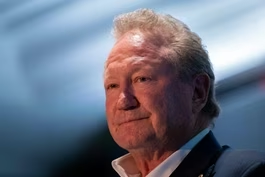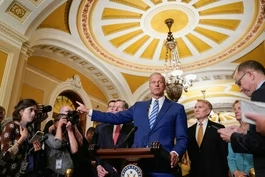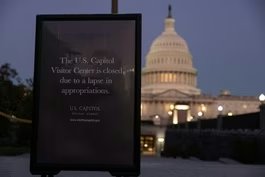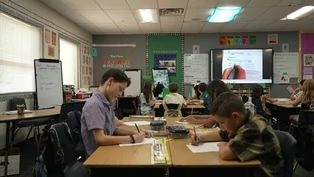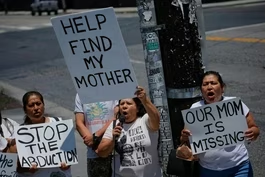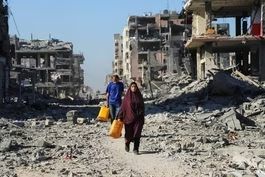
What justices signaled in Supreme Court redistricting case
Clip: 10/15/2025 | 7m 21sVideo has Closed Captions
What the justices signaled in a Supreme Court case that could reshape electoral maps
The Supreme Court’s conservative majority signaled it could upend a central pillar of the 1965 Voting Rights Act. The question at the heart of arguments is whether lawmakers can use race as a factor when drawing congressional districts. Ali Rogin discussed the case's potential to reshape electoral maps with News Hour Supreme Court analyst and SCOTUSblog co-founder Amy Howe and David Wasserman.
Problems playing video? | Closed Captioning Feedback
Problems playing video? | Closed Captioning Feedback
Major corporate funding for the PBS News Hour is provided by BDO, BNSF, Consumer Cellular, American Cruise Lines, and Raymond James. Funding for the PBS NewsHour Weekend is provided by...

What justices signaled in Supreme Court redistricting case
Clip: 10/15/2025 | 7m 21sVideo has Closed Captions
The Supreme Court’s conservative majority signaled it could upend a central pillar of the 1965 Voting Rights Act. The question at the heart of arguments is whether lawmakers can use race as a factor when drawing congressional districts. Ali Rogin discussed the case's potential to reshape electoral maps with News Hour Supreme Court analyst and SCOTUSblog co-founder Amy Howe and David Wasserman.
Problems playing video? | Closed Captioning Feedback
How to Watch PBS News Hour
PBS News Hour is available to stream on pbs.org and the free PBS App, available on iPhone, Apple TV, Android TV, Android smartphones, Amazon Fire TV, Amazon Fire Tablet, Roku, Samsung Smart TV, and Vizio.
Providing Support for PBS.org
Learn Moreabout PBS online sponsorshipThe Supreme Court's conservative majority signaled today it could upend a central pillar .. a move with the potential to reshape# electoral maps across the country.
ALI ROGIN: The question at the heart of# today's arguments is whether lawmakers can## use race as a factor when drawing congressional# districts.
Justices must consider whether the## 2024 creation of Louisiana's second majority# Black district violated the Constitution.
Here to break down the arguments and the# case's potential effects, I'm joined by## Amy Howe of SCOTUSblog and David Wasserman# of The Cook Political Report With Amy Walter.
So, Amy, how did we get here?
AMY HOWE: So this is a long and complicated story,## even by the standards of redistricting# cases.
So, every 10 years, we have a## census and then states have to redraw# their congressional maps, among others.
So Louisiana redrew its congressional map and# in 2022 it enacted a new one that contained## one majority Black district.
The state's -- out# of six.
And the state's population is roughly## one-third Black.
So a group of Black voters# went to federal court arguing that the new map## violated Section 2 of the Voting Rights Act, which# prohibits discrimination based on race in voting## because they said it diluted# their votes based on race.
A federal court in Louisiana agreed with them that# the new map likely violated the Voting Rights Act,## and it instructed Louisiana to draw a# new map.
So Louisiana drew a new map## in 2024 that contained two majority-Black# districts.
A group of voters who described## themselves as non-African American voters# went to court, arguing that this map was## an unconstitutional racial gerrymander,# that it sorted voters based on their race.
And a three-judge district court in Louisiana# agreed with them.
So Louisiana and the Black## voters defending the 2024 map came to the Supreme# Court asking the justices to take up their case.## The justices heard oral argument in# March on the propriety of the map.
They didn't decide the case by late# June, the way that they do with the## overwhelming majority of their cases, and# instead decided to hear argument again## in the fall and asked the litigants to brief a# new question, which is whether the intentional## creation of a second majority-Black# district violated the Constitution.
ALI ROGIN: And among some of the# questions that the justices asked were## whether or not the Voting Rights Act and the# protections in it were meant to be permanent.
Here's what Justice Brett Kavanaugh said.
BRETT KAVANAUGH, U.S.
Supreme Court Associate# Justice: This court's cases in a variety of## contexts have said that race-based remedies# are permissible for a period of time,## sometimes for a long period of time, decades# in some cases, but that they should not be## indefinite and should have an end point.# And what exactly do you think the end## point should be or how would we know for the# intentional use of race to create districts?
ALI ROGIN: And so the topic that Kavanaugh# was talking about there, the permanence of## the Voting Rights Act, is that something that# featured elsewhere in this argument today?
AMY HOWE: Janai Nelson, who was the lawyer# representing the Black voters who were## defending the map in this case, and some# of the liberal justices pointed out that,## when you're talking about potential violations# of Section 2, you actually look at current## conditions.
So this is not a question of# whether or not there's a logical endpoint.
ALI ROGIN: What are the potential outcomes# here?
How might the justices decide to roll?
AMY HOWE: So there's a couple of different## outcomes.
There's a couple of# roads that they could go down.
One outcome could be to say that Section# 2 is unconstitutional, standing alone.## Another one would be one that Justice Amy# Barrett raised during the oral argument,## which would be to say not that Section 2 is# unconstitutional, but that the way that the## Supreme Court had applied it in the past few# decades has -- is itself unconstitutional.
There was some suggestion# that the Supreme Court could,## depending on the verb that you want# to use, clarify or modify some of## its decisions interpreting Section 2 in a# way that wouldn't strike down Section 2,## but would undermine the power of Section# 2 and the use of race in redistricting.
ALI ROGIN: David, what are the# implications potentially of this## case and how might it affect the landscape# of redistricting around the country?
DAVID WASSERMAN, The Cook Political Report With# Amy Walter: Ali, it's hard to overstate the## potential impact if the Supreme Court strikes# down Section 2 of the Voting Rights Act,## which is the only provision really stopping# Republican legislatures in the Deep South## from completely eliminating districts held by# Democrats, and in particular Black Democrats.
Already, we are in the midst of a# gerrymandering war between the two## parties where, under the direction of the# White House, Republicans in a number of## states have redrawn or are attempting# to redraw their districts to maximize## their share of seats.
They have primarily gone# after Democratic seats in places like Texas,## Missouri, Indiana, North Carolina that# are not majority-minority districts.
But if Section 2 were struck down, then# the robust number of districts held by## Black Democrats across the South in# states like Mississippi, Alabama,## Tennessee, Georgia, South Carolina, they# could be eliminated, leaving Republicans## with 12 more House seats and really reducing# the competitiveness of the House overall.
ALI ROGIN: And, David, it does seem# like, however the justices rule,## it's going to make a big impact.# But is any of that going to have## an effect on next year's midterm elections?
DAVID WASSERMAN: That's doubtful.
And that's## because we're likely to get a ruling at some point# in the late spring or early summer of next year.
By then, most states will have seen their# filing deadlines close and a lot of states## will have held primaries.
So it's -- it would be# too late to alter the election map.
That said,## if Democrats do take back the House in# 2026, this could give Republicans an## avenue to undo that with some margin, given# that up to a dozen seats or more in the Deep## South could be eliminated if there were no# protections for minority-majority districts.
And if there were a middle ground# ruling, then a number of districts## that are similarly unusually shaped# alongside Louisiana's Sixth District## could be revisited in federal courts.# And that could take years to adjudicate.
ALI ROGIN: Big day at the Supreme Court.
David Wasserman, Amy Howe, thank you so much,# both of yo.. AMY HOWE: Thank you.
Billionaire mining executive betting on green energy
Video has Closed Captions
Clip: 10/15/2025 | 5m 54s | Why a billionaire mining executive is betting on green energy (5m 54s)
Democratic, GOP strategists on political fallout of shutdown
Video has Closed Captions
Clip: 10/15/2025 | 8m 16s | Democratic and GOP strategists on the political fallout of the government shutdown (8m 16s)
Federal workers on how the shutdown is upending their lives
Video has Closed Captions
Clip: 10/15/2025 | 8m 4s | Federal workers describe how the shutdown is upending their jobs and daily lives (8m 4s)
How students are faring in Arizona's voucher program
Video has Closed Captions
Clip: 10/15/2025 | 8m 23s | How students are faring in Arizona's voucher program that could be adopted nationwide (8m 23s)
News Wrap: Pakistan, Afghanistan agree to ceasefire
Video has Closed Captions
Clip: 10/15/2025 | 5m 16s | News Wrap: Pakistan and Afghanistan agree to a 48-hour ceasefire after days of clashes (5m 16s)
Palestinians return to ruins where homes once stood
Video has Closed Captions
Clip: 10/15/2025 | 8m 18s | Palestinians return to ruins where homes once stood as Israel awaits remains of hostages (8m 18s)
Providing Support for PBS.org
Learn Moreabout PBS online sponsorship
- News and Public Affairs

FRONTLINE is investigative journalism that questions, explains and changes our world.

- News and Public Affairs

Amanpour and Company features conversations with leaders and decision makers.












Support for PBS provided by:
Major corporate funding for the PBS News Hour is provided by BDO, BNSF, Consumer Cellular, American Cruise Lines, and Raymond James. Funding for the PBS NewsHour Weekend is provided by...
